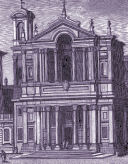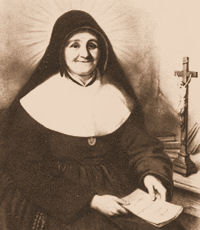Lent: April 8th
Tuesday of the Fifth Week of Lent
Other Commemorations: St. Julie Billiart, Virgin (RM)
» Enjoy our Liturgical Seasons series of e-books!
We have another ancient beautiful Lenten lesson. The division between Jesus and His enemies becomes more critical, more sharp. There are references in both readings to “being lifted up.” This reminds us of the crucifixion on Calvary and of events coming ten days from now. —The Vatican II Weekday Missal
The Roman Martyrology commemorates St. Julie Billiart (1751-1816), a French religious who founded, and was the first Superior General of, the Congregation of the Sisters of Notre Dame de Namur.
Meditation for Tuesday of the Fifth Week of Lent—Necessity of Faith in Christ’s Divinity
During the mortal life of Jesus, His Divinity as hidden under the veil of His Humanity; even for those who lived with Him, His Divinity was an object of faith.
Doubtless, the Jews were aware of the sublimity of His doctrine. “Never did man speak like this man,” they repeated. They were the witnesses of works, which, as they acknowledged, God alone could do. But they saw too that Christ was man; it is said that even His near acquaintances who had only known Him in the workshop of Nazareth did not believe in Him in spite of His miracles.
Faith in the Divinity of Christ Jesus constitutes the first step towards the divine life for us as well as for the Jews of His time. To believe that Jesus is the Son of God, God Himself, is the first condition that is necessary in order to be numbered among His sheep and be pleasing to His Father. Hoc est opus Dei ut credatis in eum quem misit ille. “This is the work of God, that you believe in Him Whom He hath sent.” We are not truly God’s children unless our life is based on this faith.
—Dom Columba Marmion, Christ the Life of the Soul

Tuesday of the Fifth Week of Lent
Station with Santa Maria in via Lata al Corso (Our Lady at Via Lata):
The Station in Rome was formerly the church of the martyr St. Cyriacus, and as such it is still given in the Roman missal; but this holy sanctuary having been destroyed, and the relics of the holy deacon translated to the church of St. Mary in Via lata, it is here that the Station is now held.
For more on Santa Maria in via Lata al Corso, see:
For further information on the Station Churches, see The Stational Church.
St. Julie Billiart
 Saint Julie was a woman completely immersed in God’s love and goodness, even in the midst of great suffering. She was a woman of vision who responded to the needs of the suffering world around her.
Saint Julie was a woman completely immersed in God’s love and goodness, even in the midst of great suffering. She was a woman of vision who responded to the needs of the suffering world around her.
Born in Cuvilly, France, on July 12, 1751, Julie lived a humble life in a loving family. She was a woman of serenity, despite the great personal suffering she endured. The Billiart family survived many hardships, including the deaths of several children. When Julie was 16, she went to work to help support her family. At the age of 23 she became paralyzed by the trauma of a shooting that was aimed at her father. She spent more than 20 years confined to her bed, unable to care for even her most basic needs.
Besides her physical pain, Julie suffered religious persecution, lived in hiding as a refugee. Throughout her suffering, she steadfastly trusted in God’s goodness. At the age of 53, Julie and her very good friend, Françoise Blin de Bourdon, along with two other women, made their vows as Sisters of Notre Dame in Amiens, France. A variety of difficult circumstances caused her to move her congregation to Namur, Belgium, several years later. Today these sisters are known as the Sisters of Notre Dame de Namur. Julie’s spirit and charism also influenced the Sisters of Notre Dame of Amersfoort, The Netherlands, as well as our own congregation of the Sisters of Notre Dame, which began in Coesfeld, Germany.
Julie reached out to the poor and forgotten, she brought comfort and hope to those around her, she encouraged faith in the seeking and the lost. More than anything else, she was a witness to the deep, loving goodness of God. Her motto and mantra was: “Oh, how good God is!” In 1969 Julie was named a saint by the Catholic Church. The impact that Saint Julie had on the world continues through the life and ministry of the sisters who share in her heritage.
—Excerpted from The Sisters of Notre Dame
Patronage: against poverty; bodily ills; impoverishment; poverty; sick people; sickness
Highlights and Things to Do:
- Read more about St. Julie:
- The Sisters of Notre Dame de Namur are still active.






